BTEC HNC Business Unit 4: Management and Operations Report - Starbucks
VerifiedAdded on 2020/12/09
|11
|2773
|155
Report
AI Summary
This report provides a comprehensive analysis of management and operations, using Starbucks as a case study. It explores the roles of leaders and managers in various situational contexts, including mergers, conflicts, and employee turnover, while also examining the application of different leadership theories such as situational, system, and contingency leadership. The report delves into the strengths and weaknesses of each approach. Furthermore, it outlines key approaches to operations management, including Total Quality Management, Lean Approach, and Six Sigma, and discusses how leaders and managers contribute to their implementation. The importance of operations management in achieving business objectives is highlighted, along with an evaluation of factors within the business environment, such as corporate social responsibility, sustainability, culture, and ethics, that affect operational management and decision-making. The report also includes an evaluation of how managers and leaders can improve the efficiency of operational management. The report concludes with a discussion of the factors within the business environment that affect operation management and decision making by leaders and managers.
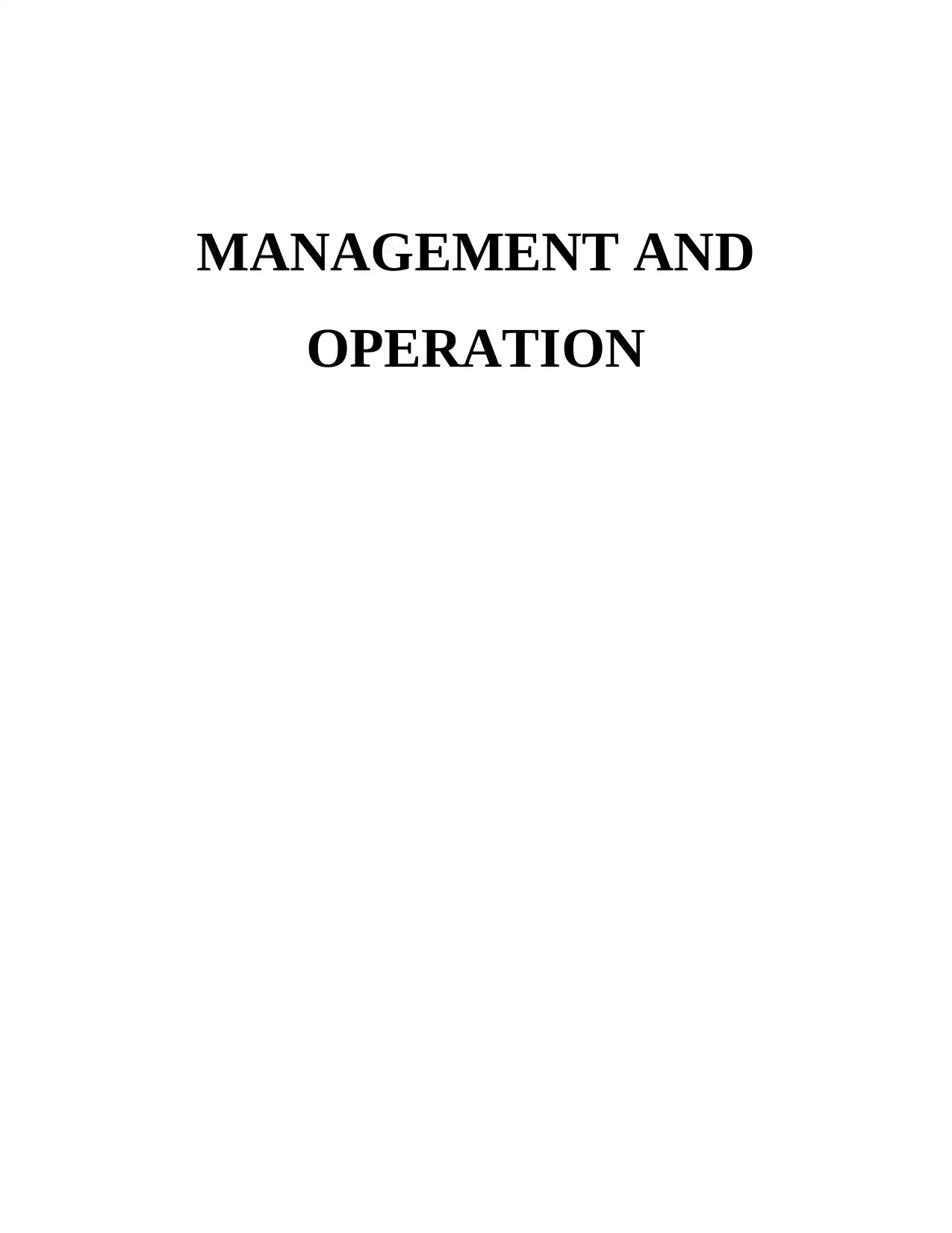
MANAGEMENT AND
OPERATION
OPERATION
Paraphrase This Document
Need a fresh take? Get an instant paraphrase of this document with our AI Paraphraser
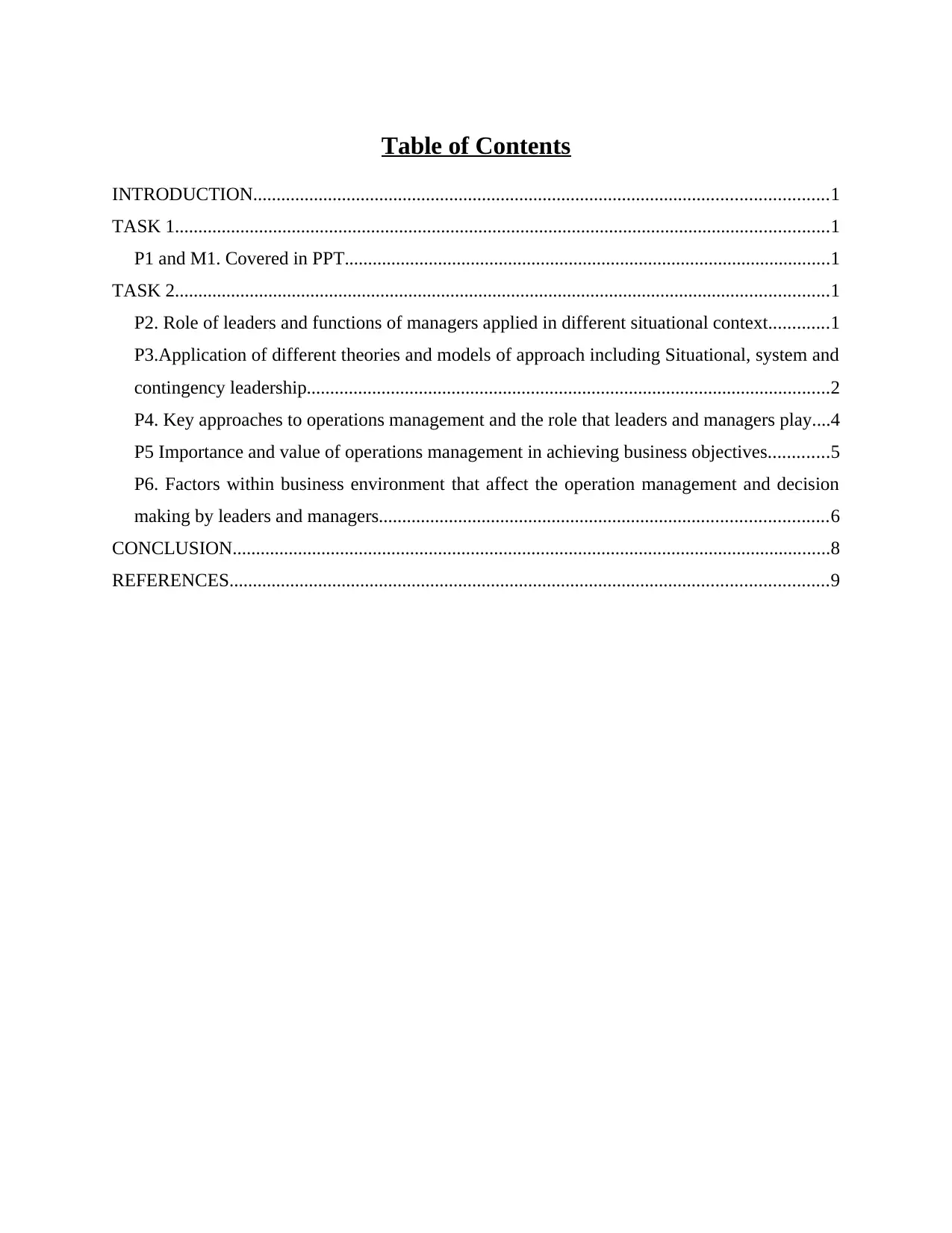
Table of Contents
INTRODUCTION...........................................................................................................................1
TASK 1............................................................................................................................................1
P1 and M1. Covered in PPT........................................................................................................1
TASK 2............................................................................................................................................1
P2. Role of leaders and functions of managers applied in different situational context.............1
P3.Application of different theories and models of approach including Situational, system and
contingency leadership................................................................................................................2
P4. Key approaches to operations management and the role that leaders and managers play....4
P5 Importance and value of operations management in achieving business objectives.............5
P6. Factors within business environment that affect the operation management and decision
making by leaders and managers................................................................................................6
CONCLUSION................................................................................................................................8
REFERENCES................................................................................................................................9
INTRODUCTION...........................................................................................................................1
TASK 1............................................................................................................................................1
P1 and M1. Covered in PPT........................................................................................................1
TASK 2............................................................................................................................................1
P2. Role of leaders and functions of managers applied in different situational context.............1
P3.Application of different theories and models of approach including Situational, system and
contingency leadership................................................................................................................2
P4. Key approaches to operations management and the role that leaders and managers play....4
P5 Importance and value of operations management in achieving business objectives.............5
P6. Factors within business environment that affect the operation management and decision
making by leaders and managers................................................................................................6
CONCLUSION................................................................................................................................8
REFERENCES................................................................................................................................9
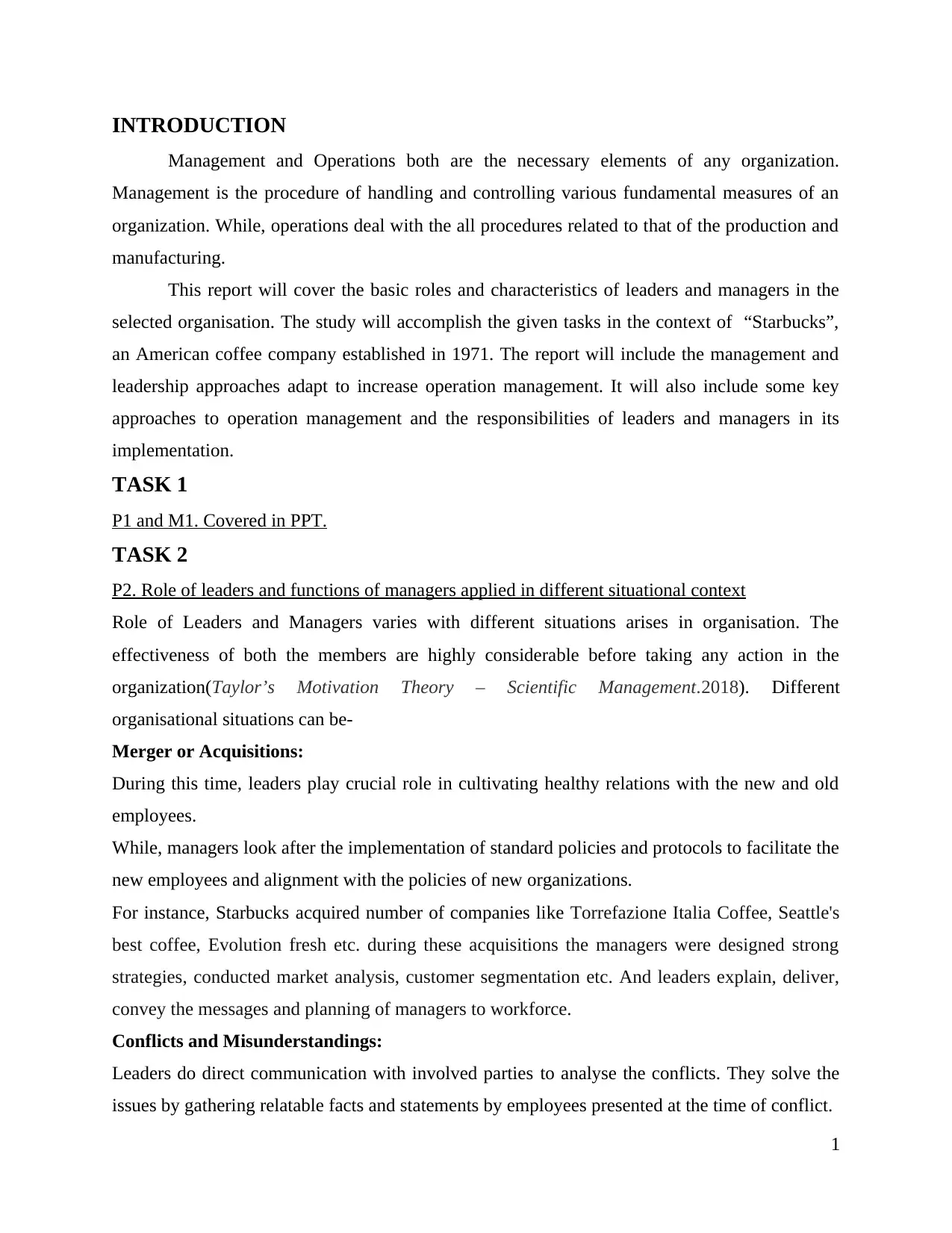
INTRODUCTION
Management and Operations both are the necessary elements of any organization.
Management is the procedure of handling and controlling various fundamental measures of an
organization. While, operations deal with the all procedures related to that of the production and
manufacturing.
This report will cover the basic roles and characteristics of leaders and managers in the
selected organisation. The study will accomplish the given tasks in the context of “Starbucks”,
an American coffee company established in 1971. The report will include the management and
leadership approaches adapt to increase operation management. It will also include some key
approaches to operation management and the responsibilities of leaders and managers in its
implementation.
TASK 1
P1 and M1. Covered in PPT.
TASK 2
P2. Role of leaders and functions of managers applied in different situational context
Role of Leaders and Managers varies with different situations arises in organisation. The
effectiveness of both the members are highly considerable before taking any action in the
organization(Taylor’s Motivation Theory – Scientific Management.2018). Different
organisational situations can be-
Merger or Acquisitions:
During this time, leaders play crucial role in cultivating healthy relations with the new and old
employees.
While, managers look after the implementation of standard policies and protocols to facilitate the
new employees and alignment with the policies of new organizations.
For instance, Starbucks acquired number of companies like Torrefazione Italia Coffee, Seattle's
best coffee, Evolution fresh etc. during these acquisitions the managers were designed strong
strategies, conducted market analysis, customer segmentation etc. And leaders explain, deliver,
convey the messages and planning of managers to workforce.
Conflicts and Misunderstandings:
Leaders do direct communication with involved parties to analyse the conflicts. They solve the
issues by gathering relatable facts and statements by employees presented at the time of conflict.
1
Management and Operations both are the necessary elements of any organization.
Management is the procedure of handling and controlling various fundamental measures of an
organization. While, operations deal with the all procedures related to that of the production and
manufacturing.
This report will cover the basic roles and characteristics of leaders and managers in the
selected organisation. The study will accomplish the given tasks in the context of “Starbucks”,
an American coffee company established in 1971. The report will include the management and
leadership approaches adapt to increase operation management. It will also include some key
approaches to operation management and the responsibilities of leaders and managers in its
implementation.
TASK 1
P1 and M1. Covered in PPT.
TASK 2
P2. Role of leaders and functions of managers applied in different situational context
Role of Leaders and Managers varies with different situations arises in organisation. The
effectiveness of both the members are highly considerable before taking any action in the
organization(Taylor’s Motivation Theory – Scientific Management.2018). Different
organisational situations can be-
Merger or Acquisitions:
During this time, leaders play crucial role in cultivating healthy relations with the new and old
employees.
While, managers look after the implementation of standard policies and protocols to facilitate the
new employees and alignment with the policies of new organizations.
For instance, Starbucks acquired number of companies like Torrefazione Italia Coffee, Seattle's
best coffee, Evolution fresh etc. during these acquisitions the managers were designed strong
strategies, conducted market analysis, customer segmentation etc. And leaders explain, deliver,
convey the messages and planning of managers to workforce.
Conflicts and Misunderstandings:
Leaders do direct communication with involved parties to analyse the conflicts. They solve the
issues by gathering relatable facts and statements by employees presented at the time of conflict.
1
⊘ This is a preview!⊘
Do you want full access?
Subscribe today to unlock all pages.

Trusted by 1+ million students worldwide
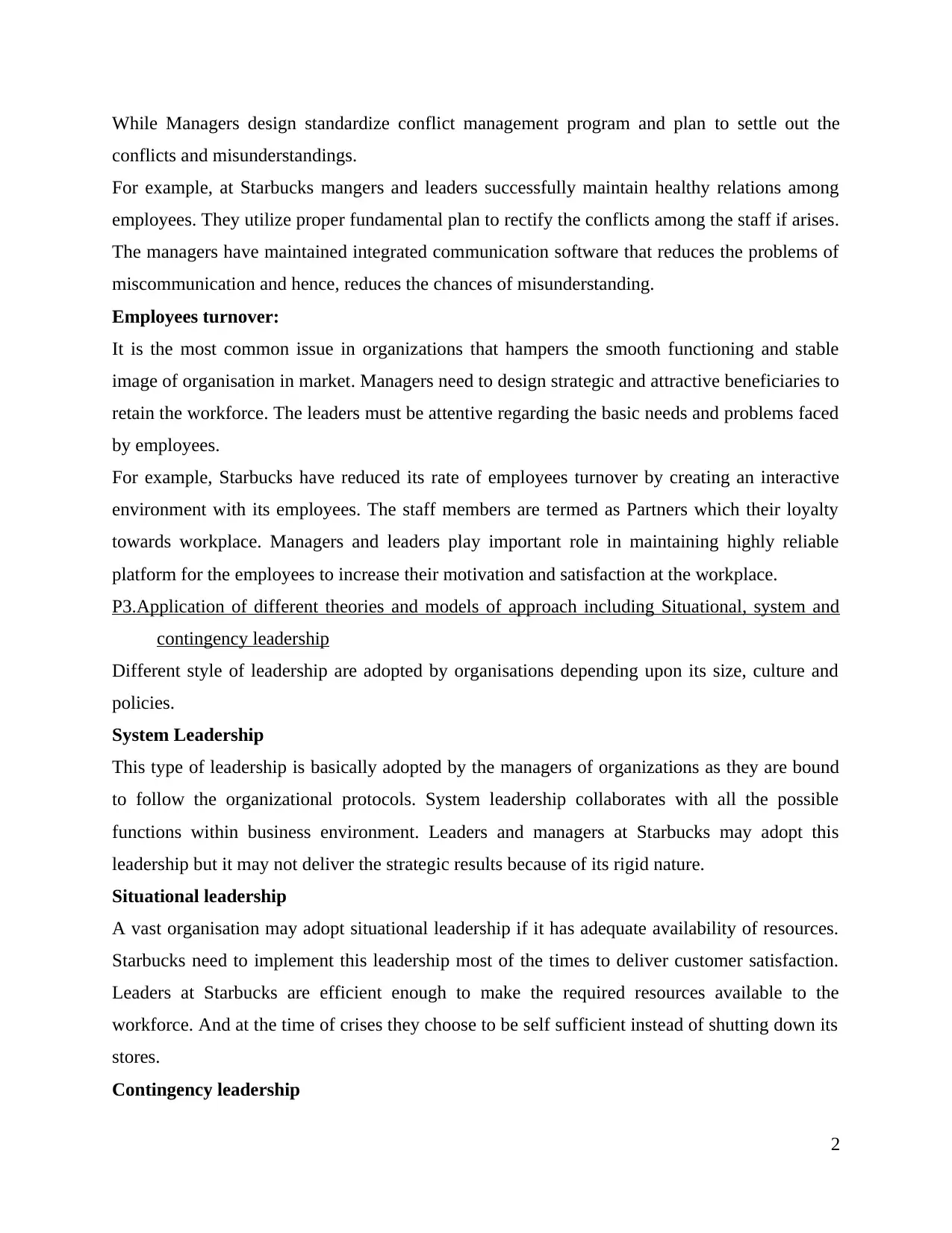
While Managers design standardize conflict management program and plan to settle out the
conflicts and misunderstandings.
For example, at Starbucks mangers and leaders successfully maintain healthy relations among
employees. They utilize proper fundamental plan to rectify the conflicts among the staff if arises.
The managers have maintained integrated communication software that reduces the problems of
miscommunication and hence, reduces the chances of misunderstanding.
Employees turnover:
It is the most common issue in organizations that hampers the smooth functioning and stable
image of organisation in market. Managers need to design strategic and attractive beneficiaries to
retain the workforce. The leaders must be attentive regarding the basic needs and problems faced
by employees.
For example, Starbucks have reduced its rate of employees turnover by creating an interactive
environment with its employees. The staff members are termed as Partners which their loyalty
towards workplace. Managers and leaders play important role in maintaining highly reliable
platform for the employees to increase their motivation and satisfaction at the workplace.
P3.Application of different theories and models of approach including Situational, system and
contingency leadership
Different style of leadership are adopted by organisations depending upon its size, culture and
policies.
System Leadership
This type of leadership is basically adopted by the managers of organizations as they are bound
to follow the organizational protocols. System leadership collaborates with all the possible
functions within business environment. Leaders and managers at Starbucks may adopt this
leadership but it may not deliver the strategic results because of its rigid nature.
Situational leadership
A vast organisation may adopt situational leadership if it has adequate availability of resources.
Starbucks need to implement this leadership most of the times to deliver customer satisfaction.
Leaders at Starbucks are efficient enough to make the required resources available to the
workforce. And at the time of crises they choose to be self sufficient instead of shutting down its
stores.
Contingency leadership
2
conflicts and misunderstandings.
For example, at Starbucks mangers and leaders successfully maintain healthy relations among
employees. They utilize proper fundamental plan to rectify the conflicts among the staff if arises.
The managers have maintained integrated communication software that reduces the problems of
miscommunication and hence, reduces the chances of misunderstanding.
Employees turnover:
It is the most common issue in organizations that hampers the smooth functioning and stable
image of organisation in market. Managers need to design strategic and attractive beneficiaries to
retain the workforce. The leaders must be attentive regarding the basic needs and problems faced
by employees.
For example, Starbucks have reduced its rate of employees turnover by creating an interactive
environment with its employees. The staff members are termed as Partners which their loyalty
towards workplace. Managers and leaders play important role in maintaining highly reliable
platform for the employees to increase their motivation and satisfaction at the workplace.
P3.Application of different theories and models of approach including Situational, system and
contingency leadership
Different style of leadership are adopted by organisations depending upon its size, culture and
policies.
System Leadership
This type of leadership is basically adopted by the managers of organizations as they are bound
to follow the organizational protocols. System leadership collaborates with all the possible
functions within business environment. Leaders and managers at Starbucks may adopt this
leadership but it may not deliver the strategic results because of its rigid nature.
Situational leadership
A vast organisation may adopt situational leadership if it has adequate availability of resources.
Starbucks need to implement this leadership most of the times to deliver customer satisfaction.
Leaders at Starbucks are efficient enough to make the required resources available to the
workforce. And at the time of crises they choose to be self sufficient instead of shutting down its
stores.
Contingency leadership
2
Paraphrase This Document
Need a fresh take? Get an instant paraphrase of this document with our AI Paraphraser
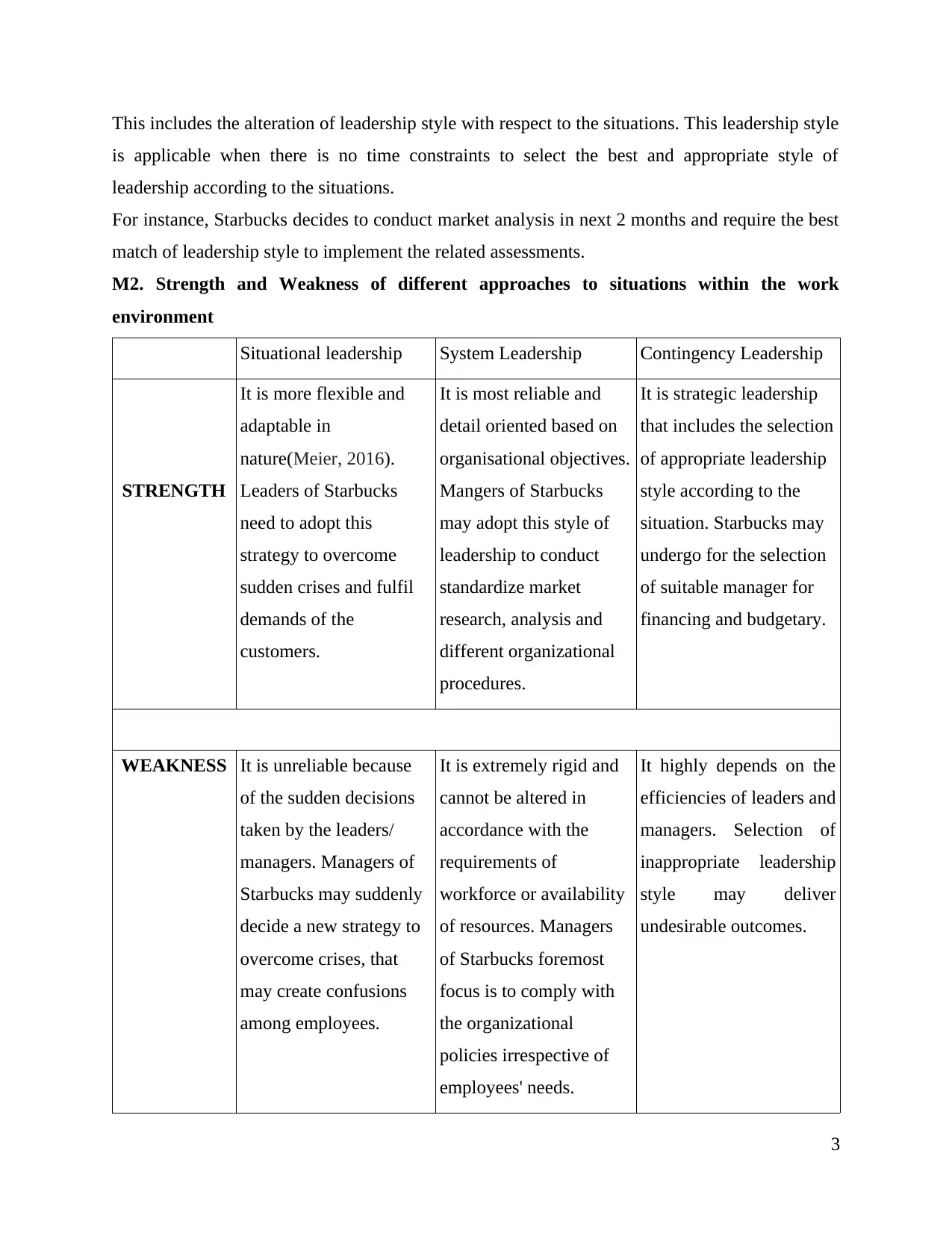
This includes the alteration of leadership style with respect to the situations. This leadership style
is applicable when there is no time constraints to select the best and appropriate style of
leadership according to the situations.
For instance, Starbucks decides to conduct market analysis in next 2 months and require the best
match of leadership style to implement the related assessments.
M2. Strength and Weakness of different approaches to situations within the work
environment
Situational leadership System Leadership Contingency Leadership
STRENGTH
It is more flexible and
adaptable in
nature(Meier, 2016).
Leaders of Starbucks
need to adopt this
strategy to overcome
sudden crises and fulfil
demands of the
customers.
It is most reliable and
detail oriented based on
organisational objectives.
Mangers of Starbucks
may adopt this style of
leadership to conduct
standardize market
research, analysis and
different organizational
procedures.
It is strategic leadership
that includes the selection
of appropriate leadership
style according to the
situation. Starbucks may
undergo for the selection
of suitable manager for
financing and budgetary.
WEAKNESS It is unreliable because
of the sudden decisions
taken by the leaders/
managers. Managers of
Starbucks may suddenly
decide a new strategy to
overcome crises, that
may create confusions
among employees.
It is extremely rigid and
cannot be altered in
accordance with the
requirements of
workforce or availability
of resources. Managers
of Starbucks foremost
focus is to comply with
the organizational
policies irrespective of
employees' needs.
It highly depends on the
efficiencies of leaders and
managers. Selection of
inappropriate leadership
style may deliver
undesirable outcomes.
3
is applicable when there is no time constraints to select the best and appropriate style of
leadership according to the situations.
For instance, Starbucks decides to conduct market analysis in next 2 months and require the best
match of leadership style to implement the related assessments.
M2. Strength and Weakness of different approaches to situations within the work
environment
Situational leadership System Leadership Contingency Leadership
STRENGTH
It is more flexible and
adaptable in
nature(Meier, 2016).
Leaders of Starbucks
need to adopt this
strategy to overcome
sudden crises and fulfil
demands of the
customers.
It is most reliable and
detail oriented based on
organisational objectives.
Mangers of Starbucks
may adopt this style of
leadership to conduct
standardize market
research, analysis and
different organizational
procedures.
It is strategic leadership
that includes the selection
of appropriate leadership
style according to the
situation. Starbucks may
undergo for the selection
of suitable manager for
financing and budgetary.
WEAKNESS It is unreliable because
of the sudden decisions
taken by the leaders/
managers. Managers of
Starbucks may suddenly
decide a new strategy to
overcome crises, that
may create confusions
among employees.
It is extremely rigid and
cannot be altered in
accordance with the
requirements of
workforce or availability
of resources. Managers
of Starbucks foremost
focus is to comply with
the organizational
policies irrespective of
employees' needs.
It highly depends on the
efficiencies of leaders and
managers. Selection of
inappropriate leadership
style may deliver
undesirable outcomes.
3
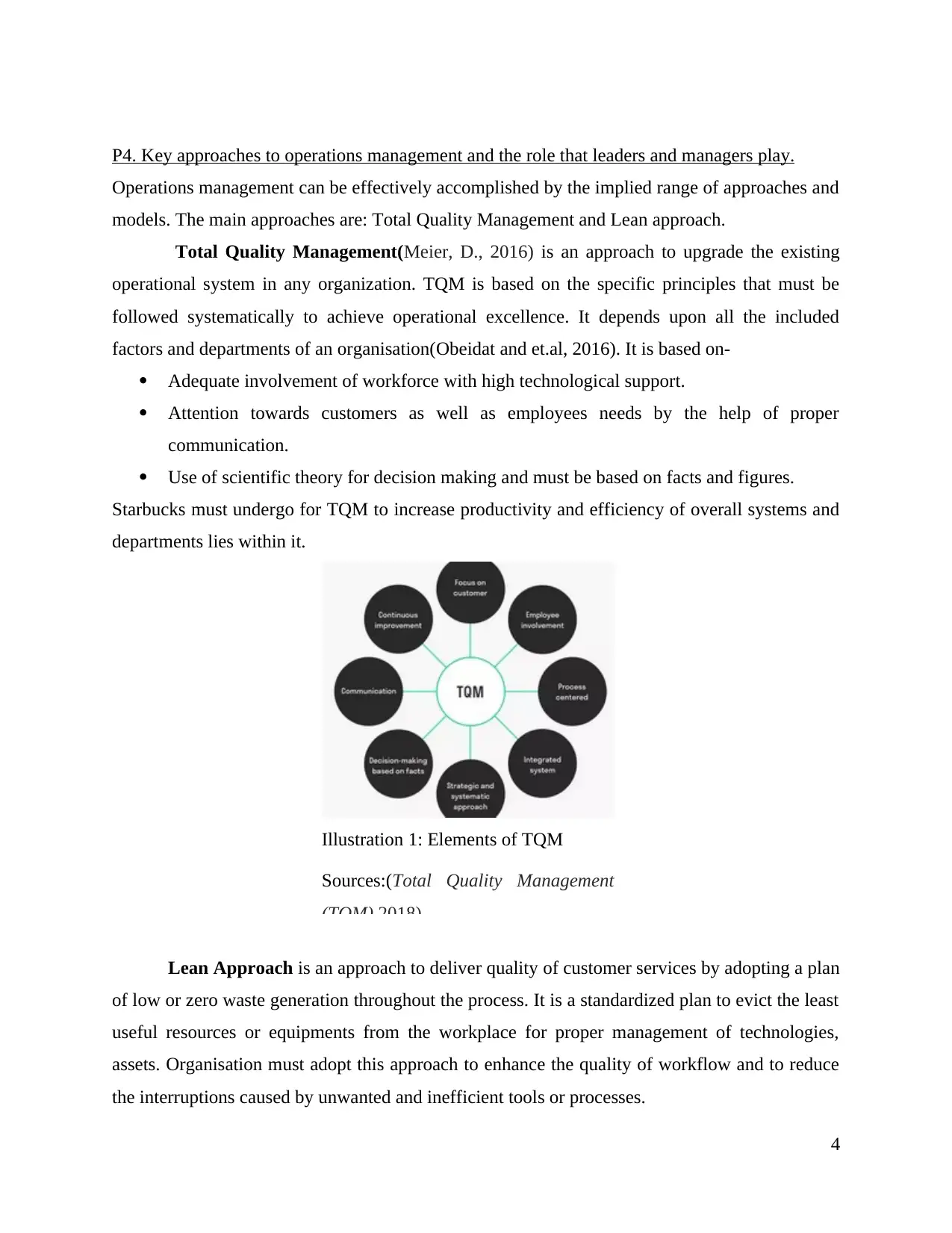
P4. Key approaches to operations management and the role that leaders and managers play.
Operations management can be effectively accomplished by the implied range of approaches and
models. The main approaches are: Total Quality Management and Lean approach.
Total Quality Management(Meier, D., 2016) is an approach to upgrade the existing
operational system in any organization. TQM is based on the specific principles that must be
followed systematically to achieve operational excellence. It depends upon all the included
factors and departments of an organisation(Obeidat and et.al, 2016). It is based on-
Adequate involvement of workforce with high technological support.
Attention towards customers as well as employees needs by the help of proper
communication.
Use of scientific theory for decision making and must be based on facts and figures.
Starbucks must undergo for TQM to increase productivity and efficiency of overall systems and
departments lies within it.
Lean Approach is an approach to deliver quality of customer services by adopting a plan
of low or zero waste generation throughout the process. It is a standardized plan to evict the least
useful resources or equipments from the workplace for proper management of technologies,
assets. Organisation must adopt this approach to enhance the quality of workflow and to reduce
the interruptions caused by unwanted and inefficient tools or processes.
4
Illustration 1: Elements of TQM
Sources:(Total Quality Management
(TQM).2018).
Operations management can be effectively accomplished by the implied range of approaches and
models. The main approaches are: Total Quality Management and Lean approach.
Total Quality Management(Meier, D., 2016) is an approach to upgrade the existing
operational system in any organization. TQM is based on the specific principles that must be
followed systematically to achieve operational excellence. It depends upon all the included
factors and departments of an organisation(Obeidat and et.al, 2016). It is based on-
Adequate involvement of workforce with high technological support.
Attention towards customers as well as employees needs by the help of proper
communication.
Use of scientific theory for decision making and must be based on facts and figures.
Starbucks must undergo for TQM to increase productivity and efficiency of overall systems and
departments lies within it.
Lean Approach is an approach to deliver quality of customer services by adopting a plan
of low or zero waste generation throughout the process. It is a standardized plan to evict the least
useful resources or equipments from the workplace for proper management of technologies,
assets. Organisation must adopt this approach to enhance the quality of workflow and to reduce
the interruptions caused by unwanted and inefficient tools or processes.
4
Illustration 1: Elements of TQM
Sources:(Total Quality Management
(TQM).2018).
⊘ This is a preview!⊘
Do you want full access?
Subscribe today to unlock all pages.

Trusted by 1+ million students worldwide
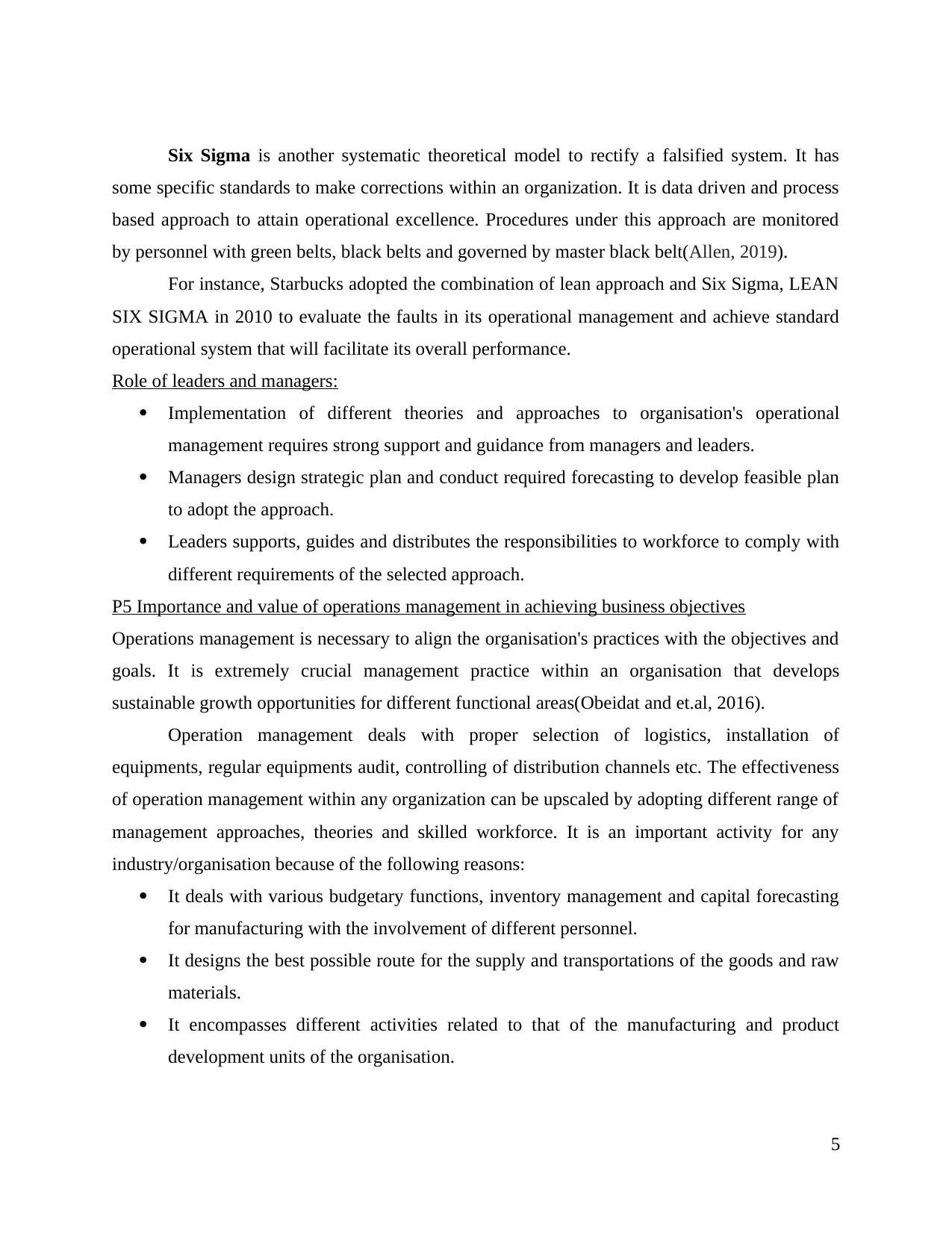
Six Sigma is another systematic theoretical model to rectify a falsified system. It has
some specific standards to make corrections within an organization. It is data driven and process
based approach to attain operational excellence. Procedures under this approach are monitored
by personnel with green belts, black belts and governed by master black belt(Allen, 2019).
For instance, Starbucks adopted the combination of lean approach and Six Sigma, LEAN
SIX SIGMA in 2010 to evaluate the faults in its operational management and achieve standard
operational system that will facilitate its overall performance.
Role of leaders and managers:
Implementation of different theories and approaches to organisation's operational
management requires strong support and guidance from managers and leaders.
Managers design strategic plan and conduct required forecasting to develop feasible plan
to adopt the approach.
Leaders supports, guides and distributes the responsibilities to workforce to comply with
different requirements of the selected approach.
P5 Importance and value of operations management in achieving business objectives
Operations management is necessary to align the organisation's practices with the objectives and
goals. It is extremely crucial management practice within an organisation that develops
sustainable growth opportunities for different functional areas(Obeidat and et.al, 2016).
Operation management deals with proper selection of logistics, installation of
equipments, regular equipments audit, controlling of distribution channels etc. The effectiveness
of operation management within any organization can be upscaled by adopting different range of
management approaches, theories and skilled workforce. It is an important activity for any
industry/organisation because of the following reasons:
It deals with various budgetary functions, inventory management and capital forecasting
for manufacturing with the involvement of different personnel.
It designs the best possible route for the supply and transportations of the goods and raw
materials.
It encompasses different activities related to that of the manufacturing and product
development units of the organisation.
5
some specific standards to make corrections within an organization. It is data driven and process
based approach to attain operational excellence. Procedures under this approach are monitored
by personnel with green belts, black belts and governed by master black belt(Allen, 2019).
For instance, Starbucks adopted the combination of lean approach and Six Sigma, LEAN
SIX SIGMA in 2010 to evaluate the faults in its operational management and achieve standard
operational system that will facilitate its overall performance.
Role of leaders and managers:
Implementation of different theories and approaches to organisation's operational
management requires strong support and guidance from managers and leaders.
Managers design strategic plan and conduct required forecasting to develop feasible plan
to adopt the approach.
Leaders supports, guides and distributes the responsibilities to workforce to comply with
different requirements of the selected approach.
P5 Importance and value of operations management in achieving business objectives
Operations management is necessary to align the organisation's practices with the objectives and
goals. It is extremely crucial management practice within an organisation that develops
sustainable growth opportunities for different functional areas(Obeidat and et.al, 2016).
Operation management deals with proper selection of logistics, installation of
equipments, regular equipments audit, controlling of distribution channels etc. The effectiveness
of operation management within any organization can be upscaled by adopting different range of
management approaches, theories and skilled workforce. It is an important activity for any
industry/organisation because of the following reasons:
It deals with various budgetary functions, inventory management and capital forecasting
for manufacturing with the involvement of different personnel.
It designs the best possible route for the supply and transportations of the goods and raw
materials.
It encompasses different activities related to that of the manufacturing and product
development units of the organisation.
5
Paraphrase This Document
Need a fresh take? Get an instant paraphrase of this document with our AI Paraphraser
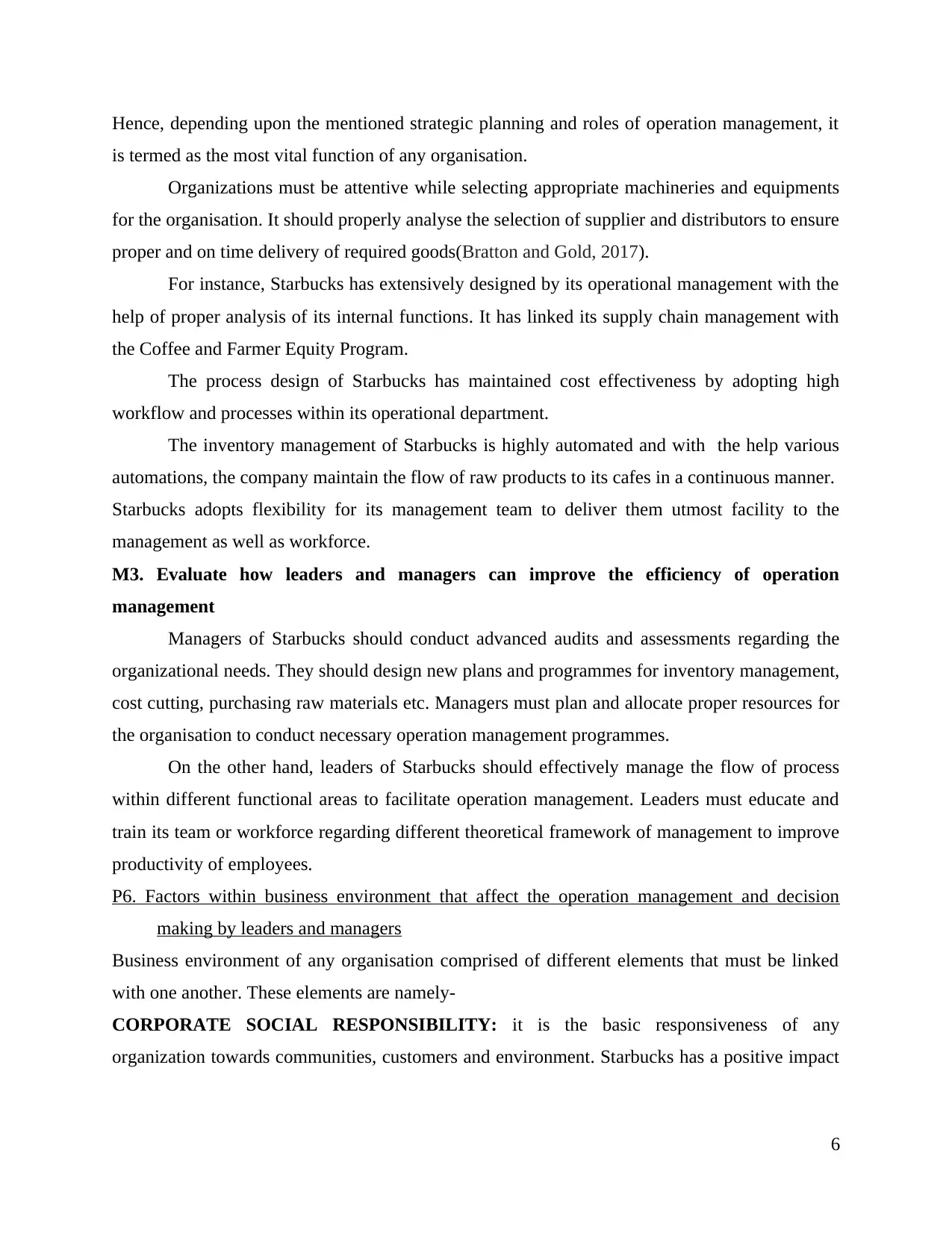
Hence, depending upon the mentioned strategic planning and roles of operation management, it
is termed as the most vital function of any organisation.
Organizations must be attentive while selecting appropriate machineries and equipments
for the organisation. It should properly analyse the selection of supplier and distributors to ensure
proper and on time delivery of required goods(Bratton and Gold, 2017).
For instance, Starbucks has extensively designed by its operational management with the
help of proper analysis of its internal functions. It has linked its supply chain management with
the Coffee and Farmer Equity Program.
The process design of Starbucks has maintained cost effectiveness by adopting high
workflow and processes within its operational department.
The inventory management of Starbucks is highly automated and with the help various
automations, the company maintain the flow of raw products to its cafes in a continuous manner.
Starbucks adopts flexibility for its management team to deliver them utmost facility to the
management as well as workforce.
M3. Evaluate how leaders and managers can improve the efficiency of operation
management
Managers of Starbucks should conduct advanced audits and assessments regarding the
organizational needs. They should design new plans and programmes for inventory management,
cost cutting, purchasing raw materials etc. Managers must plan and allocate proper resources for
the organisation to conduct necessary operation management programmes.
On the other hand, leaders of Starbucks should effectively manage the flow of process
within different functional areas to facilitate operation management. Leaders must educate and
train its team or workforce regarding different theoretical framework of management to improve
productivity of employees.
P6. Factors within business environment that affect the operation management and decision
making by leaders and managers
Business environment of any organisation comprised of different elements that must be linked
with one another. These elements are namely-
CORPORATE SOCIAL RESPONSIBILITY: it is the basic responsiveness of any
organization towards communities, customers and environment. Starbucks has a positive impact
6
is termed as the most vital function of any organisation.
Organizations must be attentive while selecting appropriate machineries and equipments
for the organisation. It should properly analyse the selection of supplier and distributors to ensure
proper and on time delivery of required goods(Bratton and Gold, 2017).
For instance, Starbucks has extensively designed by its operational management with the
help of proper analysis of its internal functions. It has linked its supply chain management with
the Coffee and Farmer Equity Program.
The process design of Starbucks has maintained cost effectiveness by adopting high
workflow and processes within its operational department.
The inventory management of Starbucks is highly automated and with the help various
automations, the company maintain the flow of raw products to its cafes in a continuous manner.
Starbucks adopts flexibility for its management team to deliver them utmost facility to the
management as well as workforce.
M3. Evaluate how leaders and managers can improve the efficiency of operation
management
Managers of Starbucks should conduct advanced audits and assessments regarding the
organizational needs. They should design new plans and programmes for inventory management,
cost cutting, purchasing raw materials etc. Managers must plan and allocate proper resources for
the organisation to conduct necessary operation management programmes.
On the other hand, leaders of Starbucks should effectively manage the flow of process
within different functional areas to facilitate operation management. Leaders must educate and
train its team or workforce regarding different theoretical framework of management to improve
productivity of employees.
P6. Factors within business environment that affect the operation management and decision
making by leaders and managers
Business environment of any organisation comprised of different elements that must be linked
with one another. These elements are namely-
CORPORATE SOCIAL RESPONSIBILITY: it is the basic responsiveness of any
organization towards communities, customers and environment. Starbucks has a positive impact
6
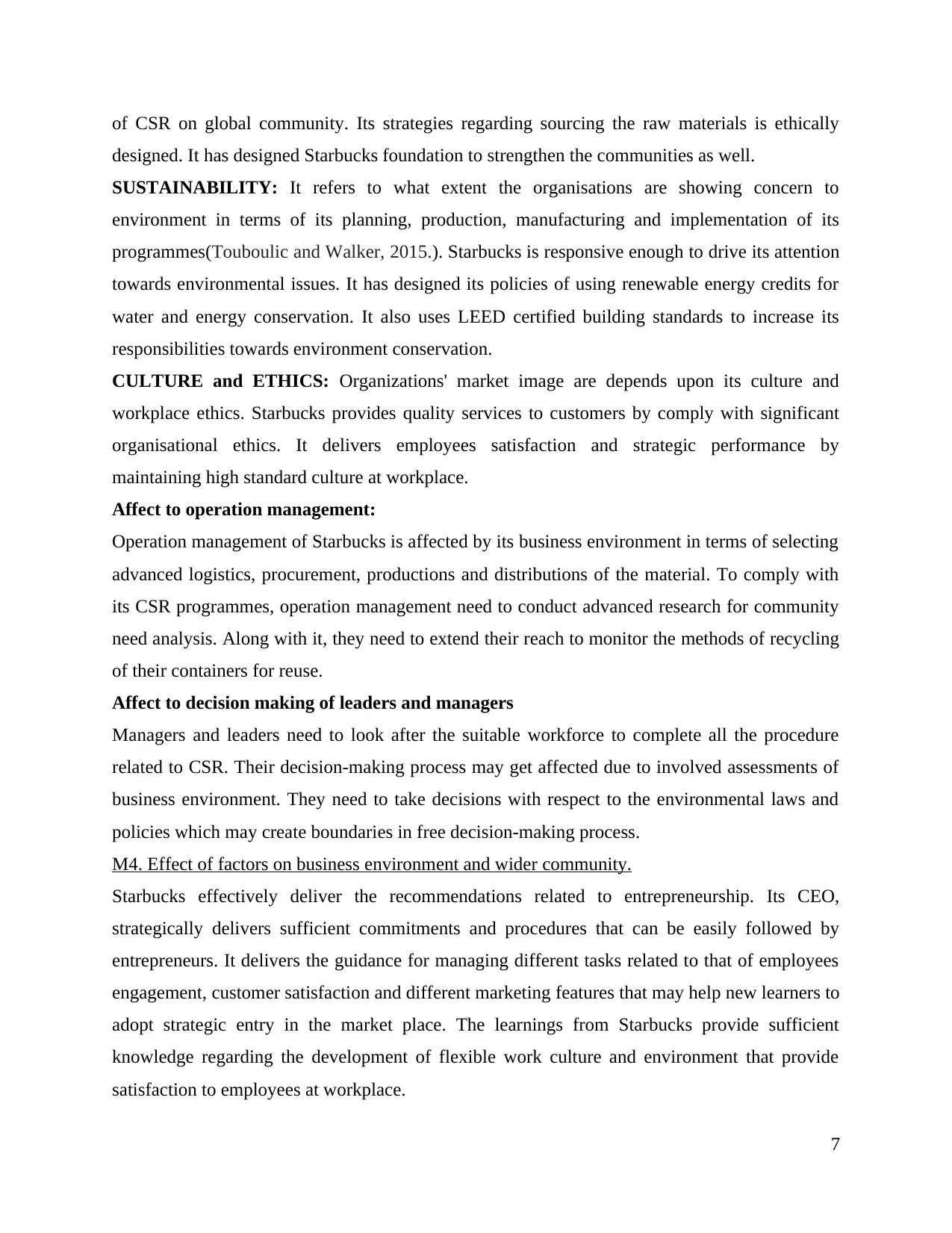
of CSR on global community. Its strategies regarding sourcing the raw materials is ethically
designed. It has designed Starbucks foundation to strengthen the communities as well.
SUSTAINABILITY: It refers to what extent the organisations are showing concern to
environment in terms of its planning, production, manufacturing and implementation of its
programmes(Touboulic and Walker, 2015.). Starbucks is responsive enough to drive its attention
towards environmental issues. It has designed its policies of using renewable energy credits for
water and energy conservation. It also uses LEED certified building standards to increase its
responsibilities towards environment conservation.
CULTURE and ETHICS: Organizations' market image are depends upon its culture and
workplace ethics. Starbucks provides quality services to customers by comply with significant
organisational ethics. It delivers employees satisfaction and strategic performance by
maintaining high standard culture at workplace.
Affect to operation management:
Operation management of Starbucks is affected by its business environment in terms of selecting
advanced logistics, procurement, productions and distributions of the material. To comply with
its CSR programmes, operation management need to conduct advanced research for community
need analysis. Along with it, they need to extend their reach to monitor the methods of recycling
of their containers for reuse.
Affect to decision making of leaders and managers
Managers and leaders need to look after the suitable workforce to complete all the procedure
related to CSR. Their decision-making process may get affected due to involved assessments of
business environment. They need to take decisions with respect to the environmental laws and
policies which may create boundaries in free decision-making process.
M4. Effect of factors on business environment and wider community.
Starbucks effectively deliver the recommendations related to entrepreneurship. Its CEO,
strategically delivers sufficient commitments and procedures that can be easily followed by
entrepreneurs. It delivers the guidance for managing different tasks related to that of employees
engagement, customer satisfaction and different marketing features that may help new learners to
adopt strategic entry in the market place. The learnings from Starbucks provide sufficient
knowledge regarding the development of flexible work culture and environment that provide
satisfaction to employees at workplace.
7
designed. It has designed Starbucks foundation to strengthen the communities as well.
SUSTAINABILITY: It refers to what extent the organisations are showing concern to
environment in terms of its planning, production, manufacturing and implementation of its
programmes(Touboulic and Walker, 2015.). Starbucks is responsive enough to drive its attention
towards environmental issues. It has designed its policies of using renewable energy credits for
water and energy conservation. It also uses LEED certified building standards to increase its
responsibilities towards environment conservation.
CULTURE and ETHICS: Organizations' market image are depends upon its culture and
workplace ethics. Starbucks provides quality services to customers by comply with significant
organisational ethics. It delivers employees satisfaction and strategic performance by
maintaining high standard culture at workplace.
Affect to operation management:
Operation management of Starbucks is affected by its business environment in terms of selecting
advanced logistics, procurement, productions and distributions of the material. To comply with
its CSR programmes, operation management need to conduct advanced research for community
need analysis. Along with it, they need to extend their reach to monitor the methods of recycling
of their containers for reuse.
Affect to decision making of leaders and managers
Managers and leaders need to look after the suitable workforce to complete all the procedure
related to CSR. Their decision-making process may get affected due to involved assessments of
business environment. They need to take decisions with respect to the environmental laws and
policies which may create boundaries in free decision-making process.
M4. Effect of factors on business environment and wider community.
Starbucks effectively deliver the recommendations related to entrepreneurship. Its CEO,
strategically delivers sufficient commitments and procedures that can be easily followed by
entrepreneurs. It delivers the guidance for managing different tasks related to that of employees
engagement, customer satisfaction and different marketing features that may help new learners to
adopt strategic entry in the market place. The learnings from Starbucks provide sufficient
knowledge regarding the development of flexible work culture and environment that provide
satisfaction to employees at workplace.
7
⊘ This is a preview!⊘
Do you want full access?
Subscribe today to unlock all pages.

Trusted by 1+ million students worldwide
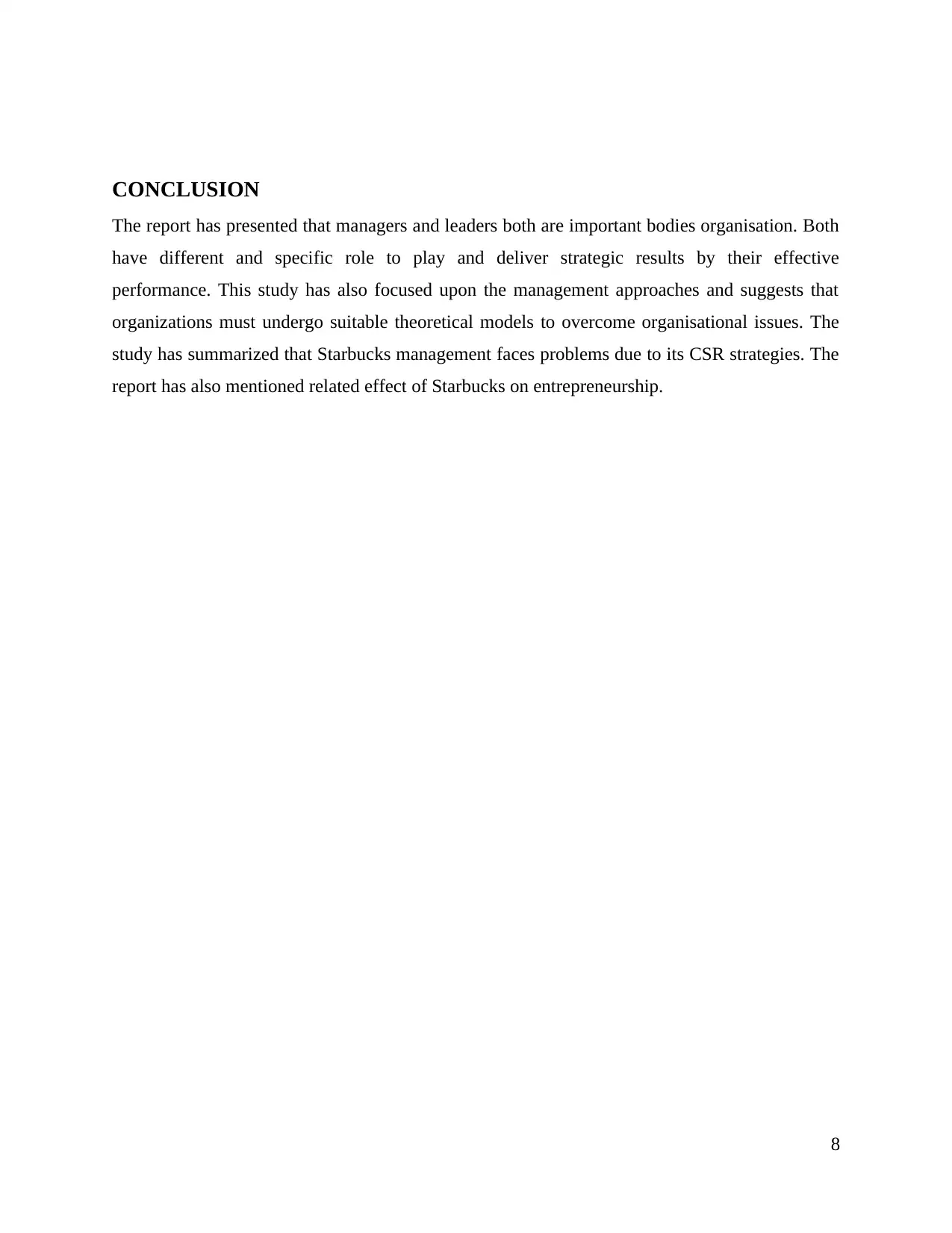
CONCLUSION
The report has presented that managers and leaders both are important bodies organisation. Both
have different and specific role to play and deliver strategic results by their effective
performance. This study has also focused upon the management approaches and suggests that
organizations must undergo suitable theoretical models to overcome organisational issues. The
study has summarized that Starbucks management faces problems due to its CSR strategies. The
report has also mentioned related effect of Starbucks on entrepreneurship.
8
The report has presented that managers and leaders both are important bodies organisation. Both
have different and specific role to play and deliver strategic results by their effective
performance. This study has also focused upon the management approaches and suggests that
organizations must undergo suitable theoretical models to overcome organisational issues. The
study has summarized that Starbucks management faces problems due to its CSR strategies. The
report has also mentioned related effect of Starbucks on entrepreneurship.
8
Paraphrase This Document
Need a fresh take? Get an instant paraphrase of this document with our AI Paraphraser
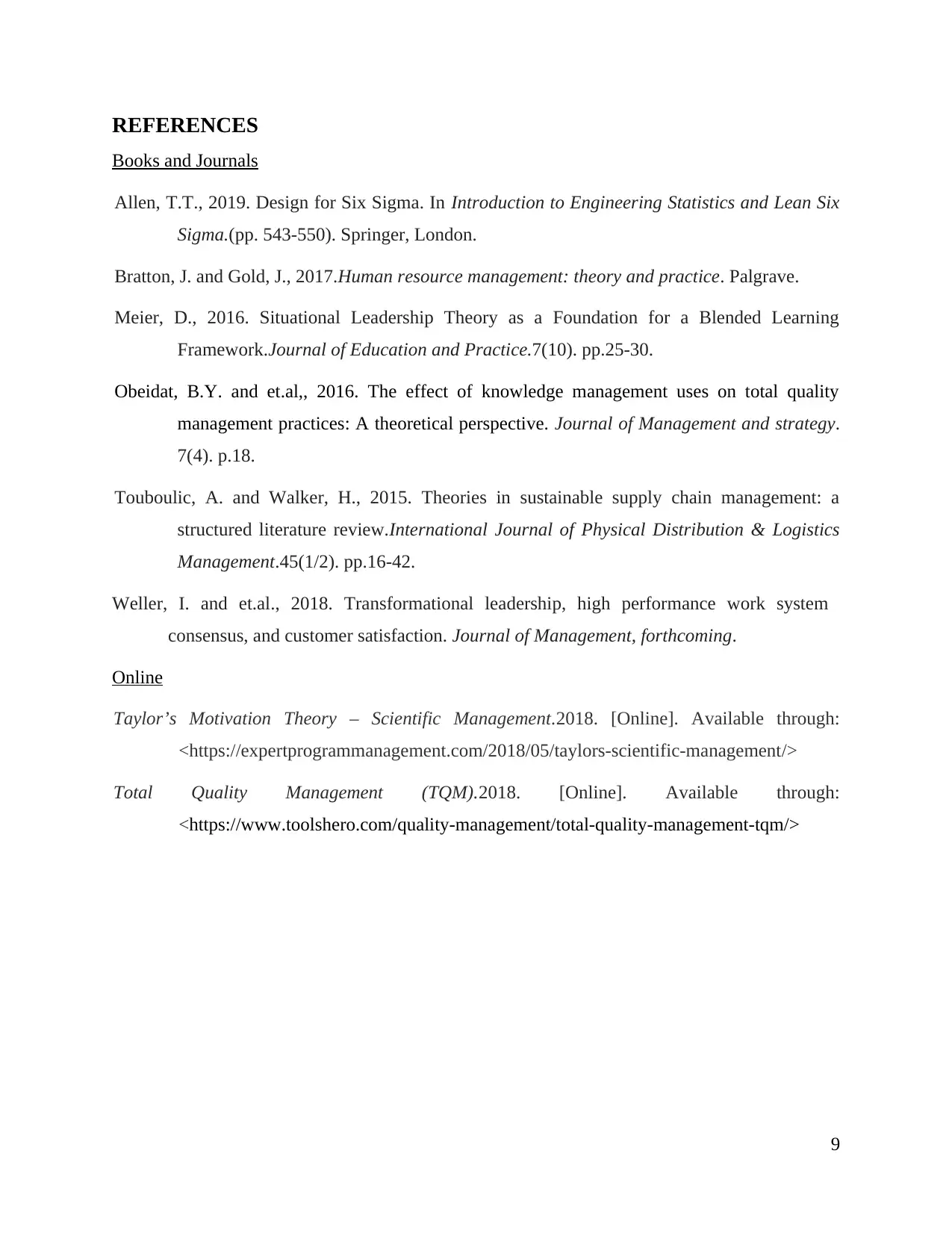
REFERENCES
Books and Journals
Allen, T.T., 2019. Design for Six Sigma. In Introduction to Engineering Statistics and Lean Six
Sigma.(pp. 543-550). Springer, London.
Bratton, J. and Gold, J., 2017.Human resource management: theory and practice. Palgrave.
Meier, D., 2016. Situational Leadership Theory as a Foundation for a Blended Learning
Framework.Journal of Education and Practice.7(10). pp.25-30.
Obeidat, B.Y. and et.al,, 2016. The effect of knowledge management uses on total quality
management practices: A theoretical perspective. Journal of Management and strategy.
7(4). p.18.
Touboulic, A. and Walker, H., 2015. Theories in sustainable supply chain management: a
structured literature review.International Journal of Physical Distribution & Logistics
Management.45(1/2). pp.16-42.
Weller, I. and et.al., 2018. Transformational leadership, high performance work system
consensus, and customer satisfaction. Journal of Management, forthcoming.
Online
Taylor’s Motivation Theory – Scientific Management.2018. [Online]. Available through:
<https://expertprogrammanagement.com/2018/05/taylors-scientific-management/>
Total Quality Management (TQM).2018. [Online]. Available through:
<https://www.toolshero.com/quality-management/total-quality-management-tqm/>
9
Books and Journals
Allen, T.T., 2019. Design for Six Sigma. In Introduction to Engineering Statistics and Lean Six
Sigma.(pp. 543-550). Springer, London.
Bratton, J. and Gold, J., 2017.Human resource management: theory and practice. Palgrave.
Meier, D., 2016. Situational Leadership Theory as a Foundation for a Blended Learning
Framework.Journal of Education and Practice.7(10). pp.25-30.
Obeidat, B.Y. and et.al,, 2016. The effect of knowledge management uses on total quality
management practices: A theoretical perspective. Journal of Management and strategy.
7(4). p.18.
Touboulic, A. and Walker, H., 2015. Theories in sustainable supply chain management: a
structured literature review.International Journal of Physical Distribution & Logistics
Management.45(1/2). pp.16-42.
Weller, I. and et.al., 2018. Transformational leadership, high performance work system
consensus, and customer satisfaction. Journal of Management, forthcoming.
Online
Taylor’s Motivation Theory – Scientific Management.2018. [Online]. Available through:
<https://expertprogrammanagement.com/2018/05/taylors-scientific-management/>
Total Quality Management (TQM).2018. [Online]. Available through:
<https://www.toolshero.com/quality-management/total-quality-management-tqm/>
9
1 out of 11
Related Documents
Your All-in-One AI-Powered Toolkit for Academic Success.
+13062052269
info@desklib.com
Available 24*7 on WhatsApp / Email
![[object Object]](/_next/static/media/star-bottom.7253800d.svg)
Unlock your academic potential
Copyright © 2020–2025 A2Z Services. All Rights Reserved. Developed and managed by ZUCOL.





